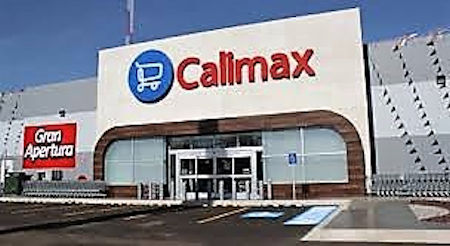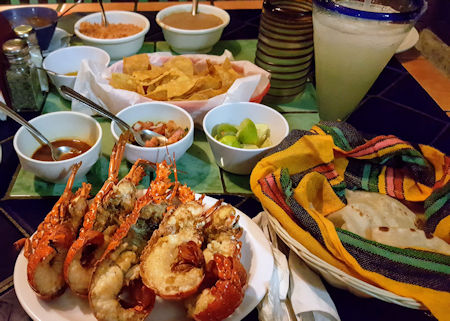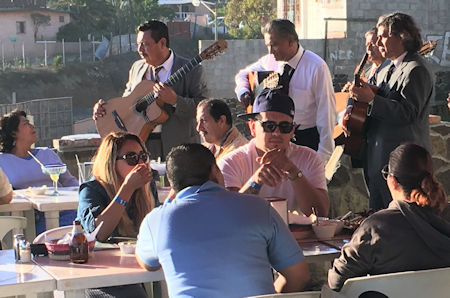 |  |
By Greg Niemann

Beginning in the mid-1960s, I’ve watched the lobster village of Puerto Nuevo, B. C. grow from a few small dwellings on a dusty bluff to a vibrant tourist destination with about 35 restaurants, paved streets, shops, and curio stands.
In the past decade alone, we’ve all experienced the explosive growth (hillside homes, high-rise condos, and restaurants, etc.). along the entire northern Baja coast. Yet I was still unprepared for Puerto Nuevo’s newest addition – a huge modern supermarket! Yes, a new Calimax market now creates an in-your-face first impression as it faces the highway from the town’s first street.
Calimax, the large supermarket chain which serves 50 million customers annually from 117 locations throughout Baja California and Sonora, opened its 98th Calimax store in Puerto Nuevo on February 21, 2019. The chain also includes one wholesale store, three distribution centers, and 15 stores called Aprecio.
According to operations director Sergio Borrayo, the company, which was founded in Tijuana in 1939, provides employment for 6,000 directly and another 15,000 indirectly. Calimax is partnered with Smart and Final and Angus Beef, and maintains its own distribution with thousands of suppliers in Mexico and the U.S. with a fleet of 200 trucks.
The new Puerto Nuevo Calimax has 22,000 square feet, off-street parking spaces, and provides employment for about 50 local people. Calimax offers more than 20,000 items for sale, about 30 percent of which are imported, mostly from the U.S.

The large market will be a boon to area residents, many of whom have been taking the bus to Rosarito (10 miles north) for similar shopping. However, some restaurant owners expressed concern over the development. They said that the new store goes against the history and gastronomic development of Puerto Nuevo and will just exacerbate the ongoing parking problem.
Casting a futile negative vote during the proposal stages, restaurant owner Rosa Marias Plascencia said, “We are not opposing the economic development of Puerto Nuevo, we just want them to do it in another area, because it’s going to change the essence of the historic and gastronomic center of Puerto Nuevo.”
For sure, the large market is an incongruous fit in a quaint village.
Named for Newport Cigarettes
It wasn’t even a village when I first discovered Puerto Nuevo. I used to stay at a friend’s place in Cantamar (before I bought my own house there in early 1970) and neighbors told us about a place we could get very fresh and very inexpensive lobster meals:
“About a quarter mile south of El Pescador restaurant, you’ll see an old white building with a huge Newport cigarette sign. Turn down the dirt road next to that building. Stop at the first house on the left and knock on the door; it’s really a restaurant. If they’re out of lobster or busy, go to the second house.”
Thus, the catch phrase around Cantamar that year often became “Let’s go to Newport.” Some of us, practicing our Spanish, started calling the place by the Spanish name for “Newport,” or “Puerto Nuevo.”
The town got its start in the early 1950s when several families relocated there from mainland Mexico. From their homes on the bluff a trail dropped down to a tiny cove. This cove allowed fishermen to penetrate the surf with shallow pangas and fish the area.
They discovered that succulent California spiny lobster were plentiful there and began to set traps. Aside from supplying local restaurants and markets with their catch, the fishermen started selling lobster and fish directly to tourists and locals alike.
It wasn’t long before the first two restaurants opened in the fishermen’s homes. Several of the families had set up tables in their living rooms. “Papa” literally passed the freshly severed lobster halves through the kitchen window to be cooked while guests gathered round to watch and choose their dinner.
The parents of Rosa Maria Plasencia opened the first one and she and her husband Enrique Murillo are still active owners. Those first two home/restaurants, now enlarged, are called Puerto Nuevo I and Puerto Nuevo II.
We grabbed our own sodas

In those early days, the customers actually felt like members of an extended family. We would just go in the kitchen and grab our own sodas or beers out of the family refrigerator. Before we left, the owners would just tally up the number of empty bottles on the table, a practice many restaurants still employ.
Even today the basic meal is almost the same in each restaurant: two halves of “Langosta” fried in lard (now if preferred, also boiled or grilled), mouth-watering hot, home-made flour tortillas, beans, rice, salsa, chips and limes, all served family style, and the term “Puerto Nuevo Style” was born. Much of the basic meal evolved due to lack of reliable refrigeration in the early days. Beans, rice, and freshly cooked lobster and tortillas hardly needed to be refrigerated.
Most of the village is related. Brothers, sisters, cousins and in-laws may all own restaurants. The Ortega family (Juan and Petra and their 10 children) arrived by the 1970s and immediately opened four restaurants. They now have five Puerto Nuevo restaurants and two in Rosarito Beach, further spreading the “Puerto Nuevo Style” fame.
A big demand for lobster
By the late ‘70s demand outpaced the supply. Long lines formed at restaurants not “sold out.” Many people were turned away, no lobster to be had. Now the village imports much of its lobster from farther south in Baja and a good many restaurants eschew offering live lobster for frozen ones.
Today the restaurants run the gamut from a few tables in a modest house to beautiful marble and tile three story extravaganzas with dramatic ocean views. The meals are fairly consistent, with most places offering mixed drinks in addition to beer and sodas, and broader menus which now even include steak. These days, some restaurants include a tortilla soup or salad, others a guacamole dip, and others a margarita included in the package lobster dinner price. Most of the places take credit cards too, but some do not. Best to check.

Most of us who have homes in the area have our favorite restaurants even though the offered fare is similar. I’ve eaten in probably 80 percent of the places and keep gravitating back to one where I’ve gotten to know the family and watched the younger ones grow up, get married and have children of their own.
The busloads and carloads of tourists that make for busy weekends at Puerto Nuevo now call for a different strategy. Do like a lot of the Mexicans and eat your main meal earlier in the day. Go during the week. Go only before Memorial Day and after Labor Day.
Puerto Nuevo is more than eating a dinner out. It can be a complete Baja experience: a bustling village, succulent food, strolling mariachis, vendors and purveyors of trinkets and freshly cut flowers, along with killer sunsets over the sparkling blue Pacific.
Today, finding Puerto Nuevo is not so cryptic. It is well identified with a toll road turn-off, a stop sign on the old road, and a welcoming arch.
But the most prominent landmark from the highway today is no longer a Newport sign. It is that bright, large, modern Calimax supermarket.
About Greg
Greg Niemann, a long-time Baja writer, is the author of Baja Fever, Baja Legends, Palm Springs Legends, Las Vegas Legends, and Big Brown: The Untold Story of UPS. Visit www.gregniemann.com.